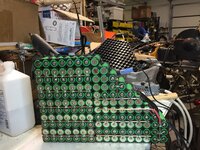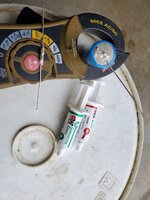You can prevent future throttle faults due to reverse rotation by removing the reverse spring inside the throttle and epoxy shut the little spring cavity (keep the tiny reverse plunger in place). Some folks didn't want to do this because we assumed Alta would release a variable braking or reverse mode using the reverse motion of the throttle. Won't happen now, at least by Alta anyway.
You are using an out of date browser. It may not display this or other websites correctly.
You should upgrade or use an alternative browser.
You should upgrade or use an alternative browser.
The R pack wirebond issue
- Thread starter snydes
- Start date
- Likes
- 2,802
- Location
- Pennsylvania
I was looking for any such products and wasn't able to find anything. Could you link such a product?Why don’t bond it back? There are low temperature hardening conductive glues..
The OEM fuse wire would not take solder for me. Perhaps with a different method? I had no luck trying.... and also very low temp solders.
The OEM fuse wire would not take solder for me.
If the fuse wire's aluminum, I've had the same problem. There's at least one guy at Endless Sphere who's successfully using soldered copper fuse wire (thread).
- Likes
- 2,802
- Location
- Pennsylvania
@rayivers , it’s definitely an aluminum alloy. We speculate it was something the manufacturer of the wirebonder specified for their process. There would be options for using a tinned copper wire in place of the aluminum, but then you are altering the characteristics of the original fusing. Would this ever be a problem? Likely not, but if you were unlucky enough to have that one cell out of the 504 suffer some sort of internal failure then it could be a bad thing.
The next issue with trying to repair a code 36 pack is this;

This was a ride where I rode the bike down low on charge, approximately 7% where this data was taken. Look at the voltage on my problem group.... yikes!!!! What do we think that is going to do to those 5 cells being discharged that low? Pretty disappointed the BMS didn’t prevent that from happening. So if you have a code 36 pack, I’d suggest not taking it below 15% SOC in order to not run those problem groups into the danger zone. At least that way you can limit the damage to them. Another good reason to have MultiTool to monitor your battery health.
The next issue with trying to repair a code 36 pack is this;

This was a ride where I rode the bike down low on charge, approximately 7% where this data was taken. Look at the voltage on my problem group.... yikes!!!! What do we think that is going to do to those 5 cells being discharged that low? Pretty disappointed the BMS didn’t prevent that from happening. So if you have a code 36 pack, I’d suggest not taking it below 15% SOC in order to not run those problem groups into the danger zone. At least that way you can limit the damage to them. Another good reason to have MultiTool to monitor your battery health.
enjoythesilenc
Well-known member
- Likes
- 263
- Location
- virginia
I was looking for any such products and wasn't able to find anything. Could you link such a product?
The OEM fuse wire would not take solder for me. Perhaps with a different method? I had no luck trying.
Interesting study:
Effective Method for Wire Bonds Rework Using Conductive Epoxy
interesting product:
https://www.amazon.com/MG-Chemicals/dp/B08PDDFS3V
interesting company in SF no less:
https://proprecisionprocess.com/
"Need Wirebonds fixed? NO PROBLEM. We have 101 ways to do this."
Perhaps less interesting ideas bouncing around my cranium, probably not included in the aforementioned "101 ways":
1. the component size we are dealing with is similar in scope to what jewelers and dentists use. Laser welding could work to reattach the loose end of the fuse wire tp the top of the cans SPOT Jewelry Laser Welder Welding Machine 200W In-Stock, US Seller,US Service | eBay
2. Imagine a barrel stave. There is a small radius of the outer edge of the cell exposed by the notch in the PCB. Take a strip of the casing from a deconstructed Sony cell. Force the strip down along the side of the cell leaving a good portion exposed. You now have only a mechanical joint but one with much more surface area than the original wirebond. you can spot weld or whatever else you want to do with the new negative "tab" far away from the fragile plastic insulating disc located in the critical area of interest.
3. more to come once these get shot down

There would be options for using a tinned copper wire in place of the aluminum, but then you are altering the characteristics of the original fusing. Would this ever be a problem? Likely not, but if you were unlucky enough to have that one cell out of the 504 suffer some sort of internal failure then it could be a bad thing.
I must have missed this reply... if the original fuse characteristics could be roughly determined by measuring an intact aluminum fuse link, then doing some web research on resistance per unit length & what other similar packs are successfully using, it should be possible to come up with a copper (or other suitable / solderable metal) functional equivalent. I'd think a slightly-higher-than-OEM blow point would be ideal in this case, as I wouldn't want to introduce a 'weak link' and in a HV series string there's no shortage of fusing.
- Likes
- 2,802
- Location
- Pennsylvania
I think if there truly was a cold solder/epoxy product that was low resistance enough, that could be the best reasonable avenue. I have a feeling though it would not be the miracle product we would like. Any mechanical contact type repair has the potential to be jarred loose and do all sorts of bad things. There may be ways to ensure it stays put but then I’d be concerned about the quality of the connection. Any soldering is really sketchy and potentially dangerous. If the failed connection wouldn’t be on the crimp/negative end (which it almost always is), it wouldn’t be as scary though.
enjoythesilenc
Well-known member
- Likes
- 263
- Location
- virginia
I'm going to order some of the epoxies out of curiosity. Also, from the thread Ray linked to is this spot-welding-fuse-wire video
enjoythesilenc
Well-known member
- Likes
- 263
- Location
- virginia
enjoythesilenc
Well-known member
- Likes
- 263
- Location
- virginia
In the first pic of the lifted wirebond. was this after you tried some sort of repair? It looks like the white plastic ring insulator is discolored there and that part of the metal rim on the battery is eroded back or ablated. I think there must be heat in the wirebond process but I don't see that discoloration on the normal wirebonds.So by now most of us regular forum rats have heard of the dreaded "code 36" issue. Code 36 indicates a voltage imbalance which could happen for a whole host of reasons. When we are talking about the 2018 R packs the culprit will likely be a disconnected cell due to some issues they had in manufacturing with the wirebonding process. The "wirebond" refers to the small aluminum wire that connects both the positive and negative points on the cell to the module PCB. This wire will act as a fuse in the event of a cell failure that could potentially save the entire pack from further damage. Unfortunately we were told very little about this problem, and that is no fault of our ex Alta friends here as they likely were prohibited to talk about it. Fortunately most of our members here that had experienced the fault were able to get their packs replaced before the shutdown. Unfortunately @Bloak and myself were not so lucky. After much frustration trying to understand what was going on inside my pack and with very little info being disclosed, I decided to see for myself what exactly was the issue. Opening up the pack is not to be taken lightly and is VERY dangerous, you should be trained in electrical safety and have the appropriate equipment to do it. If you are at all unsure DON'T DO IT! We are talking about voltages that will kill you and a battery that could turn into a firebomb. Now that we got that out of the way let me show you what the actual problem looks like;View attachment 2627
Take note to the upper most fuse on the negative connection of the cell. That is the bad connection, that's all it takes to cause this problem. I would take an wild guess that most if not all the wirebond problems were on that negative connection. Why did they all of a sudden have problems with R packs and not A packs? I think if we look at a comparison of the Panasonics used in the A packs to the Sonys used in the R packs we could make another assumption;View attachment 2628
Sonys on left, Panasonics on right (picture courtesy of AltaWest). Note the somewhat wider, flatter lip where the negative connection is made on the Panasonics. We could conclude that this smaller target was just enough to cause a nightmare with the setup of their wirebonding machine.
What can be done to repair this? At this point there is no practical repair that we know of that would not somewhat negate the engineered safety that the OEM fuse wire provided. This is essentially one of the biggest problems with "rebuilding" packs, how to recreate the fuse wire that was engineered for the pack. I think in time there will be, but for now it's still a work in progress.
This is my take on the situation, and I may be wrong about some of the conclusions I have drawn. This post is meant to educate our members so they know what the heck we are referring to when we are taking about wirebonds and fuse wire, etc.
Feel free to discuss.
- Likes
- 2,802
- Location
- Pennsylvania
That was “as found” from the original wire bond process.In the first pic of the lifted wirebond. was this after you tried some sort of repair? It looks like the white plastic ring insulator is discolored there and that part of the metal rim on the battery is eroded back or ablated. I think there must be heat in the wirebond process but I don't see that discoloration on the normal wirebonds.
The failed wire bind probably had a higher resistance connection to the cell tab, especially as it was failing. The higher resistance probably caused some local heating which would result in the discoloration you’re seeing. There may even have been a small amount of arcing when the bond finally failed.In the first pic of the lifted wirebond. was this after you tried some sort of repair? It looks like the white plastic ring insulator is discolored there and that part of the metal rim on the battery is eroded back or ablated. I think there must be heat in the wirebond process but I don't see that discoloration on the normal wirebonds.
enjoythesilenc
Well-known member
- Likes
- 263
- Location
- virginia
Great analysis.
What ever repair is attempted needs to be able to carry about 20 amps? I assumed 40kW shared by 504 cells. I think the sony cells are rated at 30 A max discharge. NKON | Sony / Murata US18650VTC6 3000mAh - 30A - Products
I like the idea posted upthread about some sort of insulator applied to the positive cap portion of the cell if someone is trying to work on the negative rim of the cell.
Another idea I have is a coil spring threaded into the cavity between the negative rim and the PCB with a tail coming out at the pcb notch then attached however to the circuit. the wire would have mechanical connection to the cell around most of the circumference, maybe enough contact patch to flow 20 A. The contact patch of the wire bonds seems so small....
I have a couple of Zero bikes. The conductors are held onto the ends of the cells only by pressure from rubber bands and shrinkwrap. Maybe a repair doesn't have to be glued, bonded, soldered, welded etc
What ever repair is attempted needs to be able to carry about 20 amps? I assumed 40kW shared by 504 cells. I think the sony cells are rated at 30 A max discharge. NKON | Sony / Murata US18650VTC6 3000mAh - 30A - Products
I like the idea posted upthread about some sort of insulator applied to the positive cap portion of the cell if someone is trying to work on the negative rim of the cell.
Another idea I have is a coil spring threaded into the cavity between the negative rim and the PCB with a tail coming out at the pcb notch then attached however to the circuit. the wire would have mechanical connection to the cell around most of the circumference, maybe enough contact patch to flow 20 A. The contact patch of the wire bonds seems so small....
I have a couple of Zero bikes. The conductors are held onto the ends of the cells only by pressure from rubber bands and shrinkwrap. Maybe a repair doesn't have to be glued, bonded, soldered, welded etc
DonCox
Well-known member
- Likes
- 616
- Location
- Lake Havasu City, AZ
As far as resoldering the wire bond back on, some one mentioned lower temp solders. The Tin / Lead 60/40 melts at 374 degrees. ( you can get it at Ace Hardware Alpha Fry 3/4 oz Repair Solder 0.05 in. D Tin/Lead 60/40 1 pc - Ace Hardware). Lead free solder melts at 430 degrees.
I built a battery pack of 420 Sony VTC6's, soldering them together. Using that solder and an iron that allows quick solder flow on the cells. This is the iron I used at 480 degree F
(https://www.amazon.com/dp/B08HCPGJLC/?tag=sce0f-20)
My gosh , what a link...
On My packs I used 1mm copper links, I thought the .5mm aluminum links were too small that are used on the Altas, but @Mark911 helped me prove that incorrect. So you easily, with a lot of precision, could resolder .5mm copper wire back on to the cell, both top and side. I don't know what the PCB material is, and can you solder to it?
You will still have the fuse protection of the other .5mm aluminum link on the cell. The link, if it acted as a fuse would blow if the cell went bad and shorted. You should check the cell before you just repair the link. If it's bad , that is another problem. Mark911 and others mentioned replacement above.
I did have a few links that were not a good solder connection, and they showed up like @snydes showed , and on my smart BMS it showed that group discharged lower than the other groups, Group 3, and that triggered end of charging, and was the highest at full charge. I didn't get a picture of the discharge state, but that group was lower, here is the charge state picture of my BMS ( DALY)


I built a battery pack of 420 Sony VTC6's, soldering them together. Using that solder and an iron that allows quick solder flow on the cells. This is the iron I used at 480 degree F
(https://www.amazon.com/dp/B08HCPGJLC/?tag=sce0f-20)
My gosh , what a link...
On My packs I used 1mm copper links, I thought the .5mm aluminum links were too small that are used on the Altas, but @Mark911 helped me prove that incorrect. So you easily, with a lot of precision, could resolder .5mm copper wire back on to the cell, both top and side. I don't know what the PCB material is, and can you solder to it?
You will still have the fuse protection of the other .5mm aluminum link on the cell. The link, if it acted as a fuse would blow if the cell went bad and shorted. You should check the cell before you just repair the link. If it's bad , that is another problem. Mark911 and others mentioned replacement above.
I did have a few links that were not a good solder connection, and they showed up like @snydes showed , and on my smart BMS it showed that group discharged lower than the other groups, Group 3, and that triggered end of charging, and was the highest at full charge. I didn't get a picture of the discharge state, but that group was lower, here is the charge state picture of my BMS ( DALY)


Similar threads
- Replies
- 18
- Views
- 4,044
- Replies
- 35
- Views
- 8,092
- Replies
- 7
- Views
- 3,152

